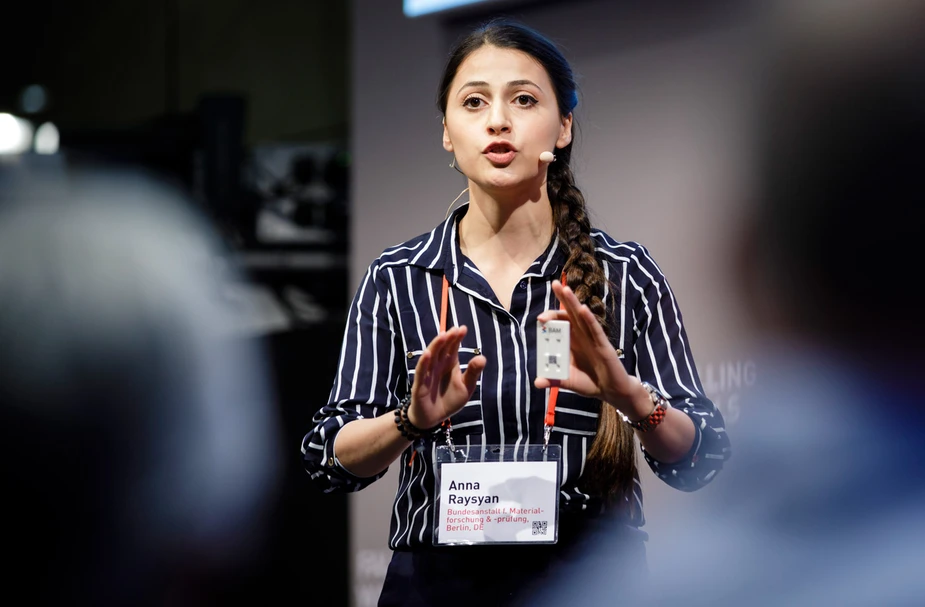Real-world ideas
Quick tests for breast milk and sewing pattern software – meet two science talents with ideas geared towards practical application on their way to becoming business owners
When Anna Raysyan is on stage, she is like fish in water. Convincingly and full of energy, she presents her idea that she hopes will soon help many women: a test for breast milk. The prototype is no larger than a matchbox and is just as simple to use – comparable to a pregnancy test. A few drops of the precious baby food are enough to test whether the milk is fit for feeding or, for example, polluted with drug traces.
Raysyan’s idea earned her second place at the Falling Walls Lab 2018 in Adlershof and qualified her for the big international finale.
She had the idea for the test, says the 25-year-old pharmacist, when her cousin gave birth. ‘Some mothers don’t breastfeed because they have to take medication, others don’t take medication to be able to breastfeed, and even others accidently feed their babies with polluted milk.’ After taking, say, the painkiller Diclofenac, the test indicates when its concentration in the breast milk has reached sound levels. To do this, Raysyan refined methods for detecting water pollutants that she researched in the course of her PhD at the Environmental Analysis Division of the BAM Federal Institute for Materials Research and Testing. ‘As a pharmacist, my focus – and this sets me apart from, let’s say, a chemist – is on secure application of pharmaceutical substances on people,’ she says.
The small test cassette is complemented by an app that answers any relevant question the users may have regarding the results. ‘I grew up with computers, so it is natural to me to integrate this type of thing,’ says Raysyan. She recently applied for patent protection for her development but the path to her idea’s commercial exploitation is long: ‘In health care, these things are rather complicated. They require lengthy studies.’ Raysyan’s PhD thesis is now her priority. Afterwards, she can well imagine continuing her work with breastmilk.
Markus Uhlig, on the other hand, has already left his PhD thesis behind – although he has not finished it. He made a clear cut – and started working on sewing patterns. For the software engineer from the Brandenburg University of Technology Cottbus-Senftenberg, this move has ushered in exciting times as a business founder. ‘To be honest, the project came to me,’ says the 32-year-old. A professor of his introduced him to Nora Baum. Baum, who has a PhD in business administration, is a passionate amateur seamstress. She was annoyed by sewing patterns: a complicated jumble of coloured lines with multiple sizes on just one sheet. Then there’s the cutting, the applying to the fabric, and the tracing of the outlines. It made it quite clear: it was time for the digital transformation of the sewing room. So, Baum and Uhlig founded the company Pattarina.
‘We were only able to do this because the underlying technology is now ripe for mobile application,’ says Uhlig. The key is augmented reality (AR) – overlaying the real world with information from the virtual world. How does this apply to sewing patterns? While looking at your fabric through the smartphone camera, you position a previously selected sewing pattern as a virtual element on it. Once positioned, you lock in the virtual pattern and, looking through the camera, use a pen or piece of chalk to draw the outlines on the fabric.
Markus Uhlig’s advanced IT skills were the basis for developing the software. Experiencing the business start-up scene has also been an inspiration for him: ‘The great thing about it is the diversity: you experience new things, meet new people, talk to your users about their needs. It is a very practical activity that creates new things every day.’
With respect to the required self-responsibility, self-motivation, and self-organisation, Uhling finds that his new job is not that different from completing a PhD thesis at university. In this respect, he feels well-prepared for his new job, which he has been doing for about a year. With a business founder’s grant in his pocket, he is eagerly awaiting the beta phase, where a selected group of customers will test the software. The product is scheduled to hit the market in the first quarter of 2019. Other potential customers of Pattarina include sewing pattern manufacturers, who can connect their products with the app via QR code.
By Dr. Uta Deffke for Adlershof Journal
